A few years ago, when ‘smart cities’ started dominating the landscape of urban trends, it seemed like a pretty exciting model. Technology integrated into every aspect of daily life; it was a more convenient, comfortable urban experience for everyone. Right?
Not really. As this article will argue, smart cities as we know them today are neither particularly clever, nor are they intended for everyone.
It’s hard to overstate how frustrating this is — partly because governments everywhere have bit into the smart cities story hook, line and sinker. In a background paper on smart cities put together last year by the United Kingdom’s Department for Business Innovation and Skills, ARUP estimates that the global market for smart urban systems (including transport, energy, sanitation and healthcare) will amount to around $400 billion per year by 2020. In other words, it’s a huge market opportunity. This is, of course, part of the attraction for companies looking for new markets and city governments looking to lure new investment.
In today’s competitive urban culture, established cities like Amsterdam, Boston and Stockholm are sticking ‘smart city’ into all their marketing material. In new, master-planned cities springing up around the global south, the ‘smart city’ narrative is incorporated from the very first speculative conversation — “What if we build a city here? It would have to be a smart city.”— all the way through to the final designs. India is currently preparing to deploy 100 new smart cities across the country and it seems like a good time to rethink how we, as practitioners and potential end users, evaluate the success of the smart city.
Although it has already been used for both sides of the smart city argument, New Songdo City outside Incheon, South Korea, is actually a great example of where smart cities get it right and where they get it very, very wrong.
Let’s start with where Songdo gets things right: the most exciting part of the Songdo story is that this entire urban development can be purchased and replicated for a mere $40 billion. By contracting every physical product and service used to build Songdo, developer Stanley Gale created the first ‘City in a box’. From door handles to elevators to internet providers, another Songdo can be purchased as one item and thus constructed in record time. Although its ability to be quickly and simply reproduced is somewhat peripheral to the more familiar smart city story, it is innovation that is the ‘smartest’ thing about New Songdo City. This level of experimentation hasn’t really been seen since the last century and it’s exciting. If this basic idea could be made more affordable and adaptable, the ground-breaking nature of Gale’s packaged approach could be one part of a solution to the urban housing crises currently prevalent in much of the global south. But only if the model could be made much more flexible and adapted to meet local cultural and climatic conditions. As we’ve learned repeatedly over the last century, the ‘one size fits all’ planning approach of the modernist era simply does not work; it’s not a mistake worth repeating.
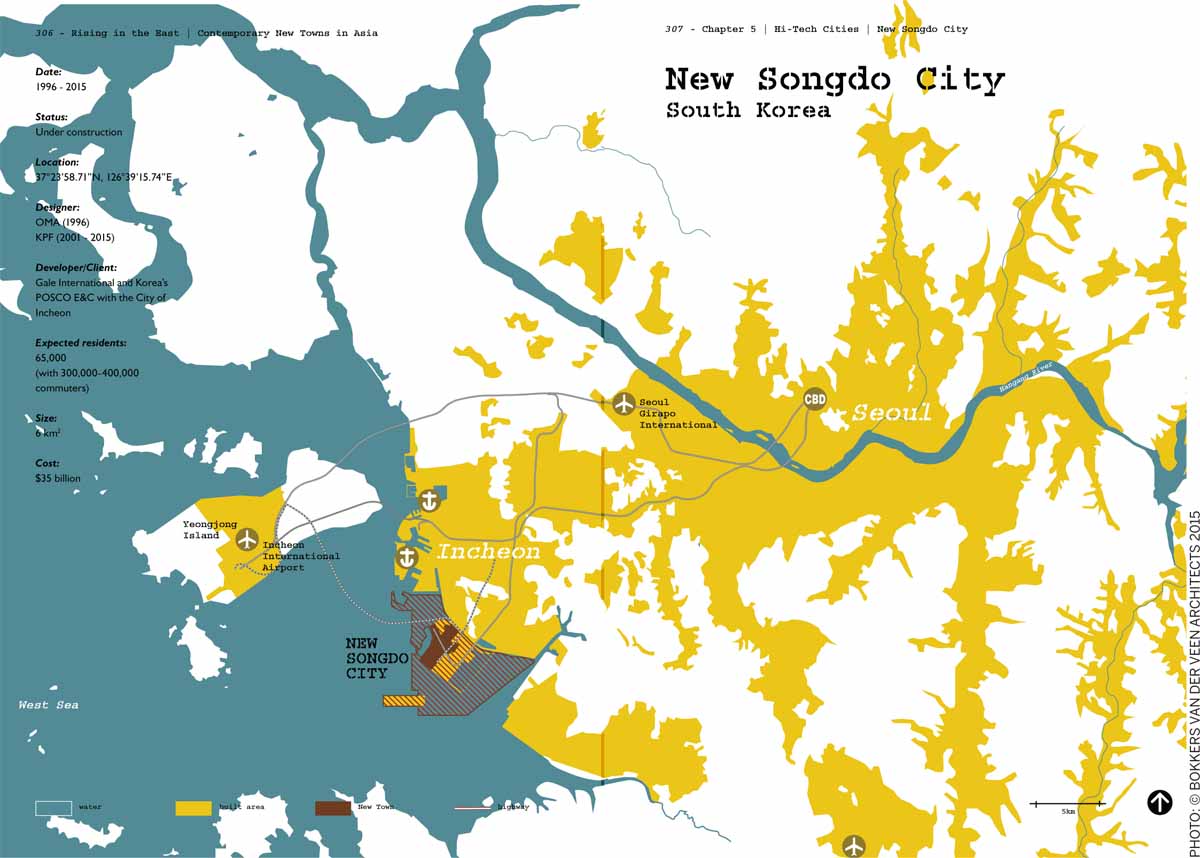
In addition, the European Commission tells us that: “In Smart Cities, digital technologies translate into better public services for citizens, better use of resources and less impact on the environment.” In Songdo, this is obvious throughout the city. Every aspect of public service is digitalised and made available to all citizens. Some 3000 volunteers are currently testing a system where they use Cisco’s telepresence screens to interact with their doctors, language tutors or extended families (imagine Skyping via television). Floors in every apartment respond to shifts in weight distribution and dial emergency services should a sudden fall be registered. The city’s garbage collection system is so automated that it only takes seven employees to serve the current 35,000 residents. That kind of efficiency is unimaginable in most cities. Although it’s not necessarily a key aspect of smart city design, Songdo is also more open and greener than many crowded South Korean cities, providing citizens with public parks, biking paths and recreation areas.
However, this is also where Songdo starts to get it wrong. Although it was designed by a sequence of well-known international design offices like OMA and KPF to combine a number of celebrated urban models (including Savannah’s neighbourhood parks, Venice’s picturesque canals and New York’s Central Park), the result is surprisingly mundane. This seems to be an issue for almost all contemporary planned smart cities. While they do provide reliable public services, the built environment they create are almost universally stifling and generic.
Most images of Songdo look like they could have been taken anywhere in the world. It’s a city of familiar glass towers, wide highways, corporate franchises and clean, anonymous sidewalks. (All of which makes it the perfect backdrop for music videos like Psy’s viral Gangnam Style.)
These cities look like the CIAM-inspired modernist cities from the 1960s, as if we’ve learned nothing over the last half century of urban planning innovation. This typology was, indeed, once seen as a panacea for cities everywhere, but is now considered a failed model that has cost some communities a heavy price. Many sociologists and historians now blame this model for rising crime rates, social exclusion, limited access to public amenities and heightened class divisions.
Planned cities often have trouble adapting to changing circumstances (sudden influx of people, aging populations and infrastructural upgrades). Because of their design, they don’t have the variety and therefore the resilience or flexibility that historic cities can exploit when necessary. In a planned city, an authentic urban identity often takes decades to build up. Many would argue that planned cities from the 1960s and 1970s like Chandigarh, Bhubaneshwar, Almere, NL or Milton Keynes, UK, are just starting to develop a kind of unique urban character. This is more worrying in a smart city because the technology is built into the fabric of the city from the ground up. Although undoubtedly state-of-the-art at the time of its construction, how will these cities age with digital infrastructure that’s stuck in 2012?
More dangerously, the planned towns and cities we now see coming up across Asia and Africa are almost exclusively for the wealthy. Unlike their socialist European forebears of the 20th Century, these developments are initiated, planned and built by the private sector, which means, simplistically: they are profit-driven. The altruistic ambitions of the previous century’s architects and town planners have been abandoned for new tools that only serve those who can afford them.
What would a smart city for the urban poor even look like?
Truly poor people can’t even afford the personal gadgets that smart cities take for granted (laptops, smart phones, reliable internet access). This exclusionary city making exacerbates spatial segregation and leads to fragmented demographics, which in turn leads to higher crime rates and heightened social tensions. Especially in emerging economies, this seems like something planners might prefer to avoid rather than encourage.
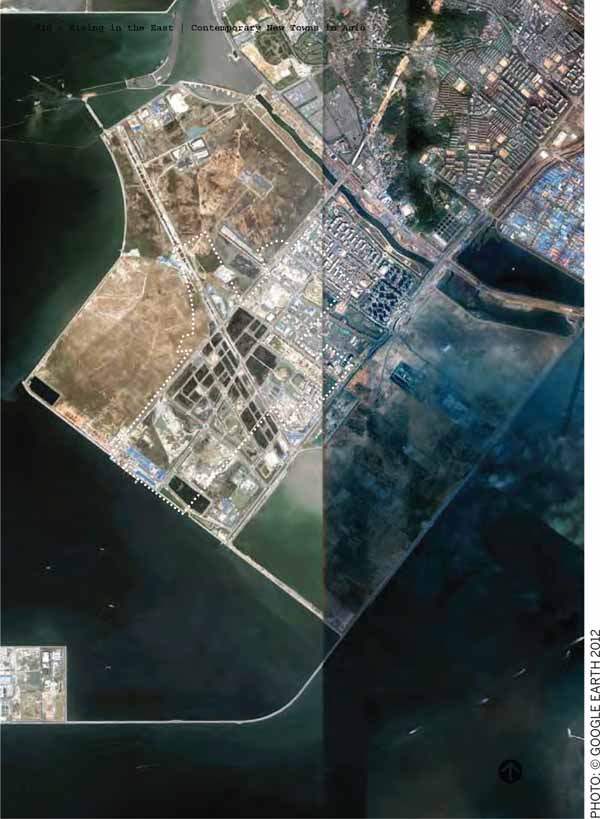
Situated in a free trade zone, Songdo becomes an attractive option for foreign and domestic investors. Officially, New Songdo City is part of the Incheon Free Economic Zone (IFEZ), an area spanning 210 km2 (52,000 acres) along the Incheon coast. The IFEZ was officially designated by the Korean Government in August 2003 (Korea’s first FEZ) as a way of encouraging international investment and creating an urban live/work setting specifically targeted to well-heeled foreigners (New Songdo City has international schools, as well as foreign medical facilities). IFEZ offers tax benefits for foreign-invested companies, support for technology introduction (in the form of tax reduction on royalties and tariff reductions), tax incentives for dividends of foreign investors and income tax exemptions for foreigners. These seem strangely misguided when considered against the backdrop of South Korea’s chronic housing shortage in the capital region and declining owner-occupation.

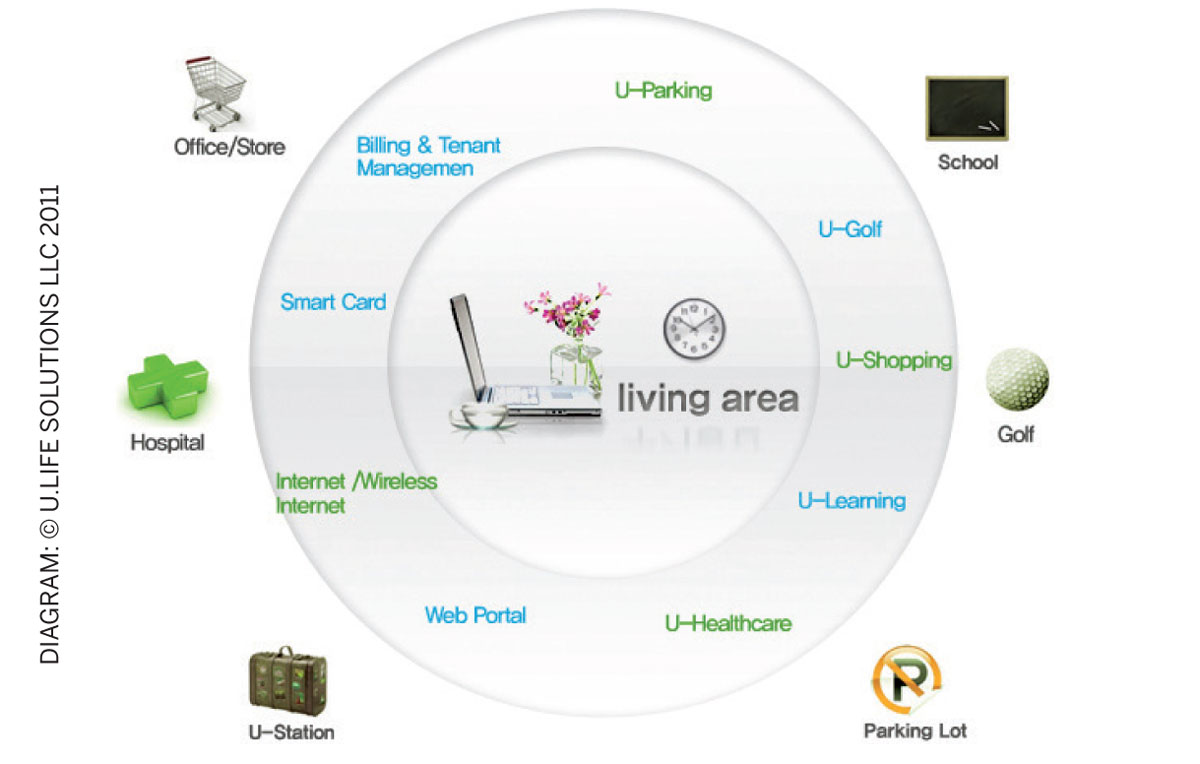
Another aspect of contemporary smart city development is the prevalence of safety and security in the urban narrative. When planned from scratch, smart cities often seem to be designed for children, rather than intelligent, ambitious citizens. The colourful kindergarten designs keep every citizen in line. Observation and the illusion of control (in Songdo, there is a pilot programme where children wear bracelets with GPS locators) are used to sell a sense of security. In New Songdo City, each resident will have a smart-card house key. According to Mr. John Kim, Vice President for Strategy at New Songdo City Development, this key “can be used to get on the subway, pay a parking meter, see a movie and even borrow a free public bicycle.It will be anonymous, won’t be linked to your identity and, if lost, you can quickly cancel the card and reset your door lock.”
Such omnipresent technology may sound a bit dubious to those of us who are still grudgingly adjusting to CCTV, however, the ‘Big Brother’ implications for this hyper-aware model of urban management seems to be more disturbing from a European perspective than for South Koreans: “In the West, ubiquitous computing is a controversial idea that raises privacy concerns and the spectre of a surveillance society... But in Asia the concept is viewed as an opportunity to show off technological prowess and attract foreign investment.” The concept is already drawing interest from Middle Eastern developers for possible applications in other contexts.
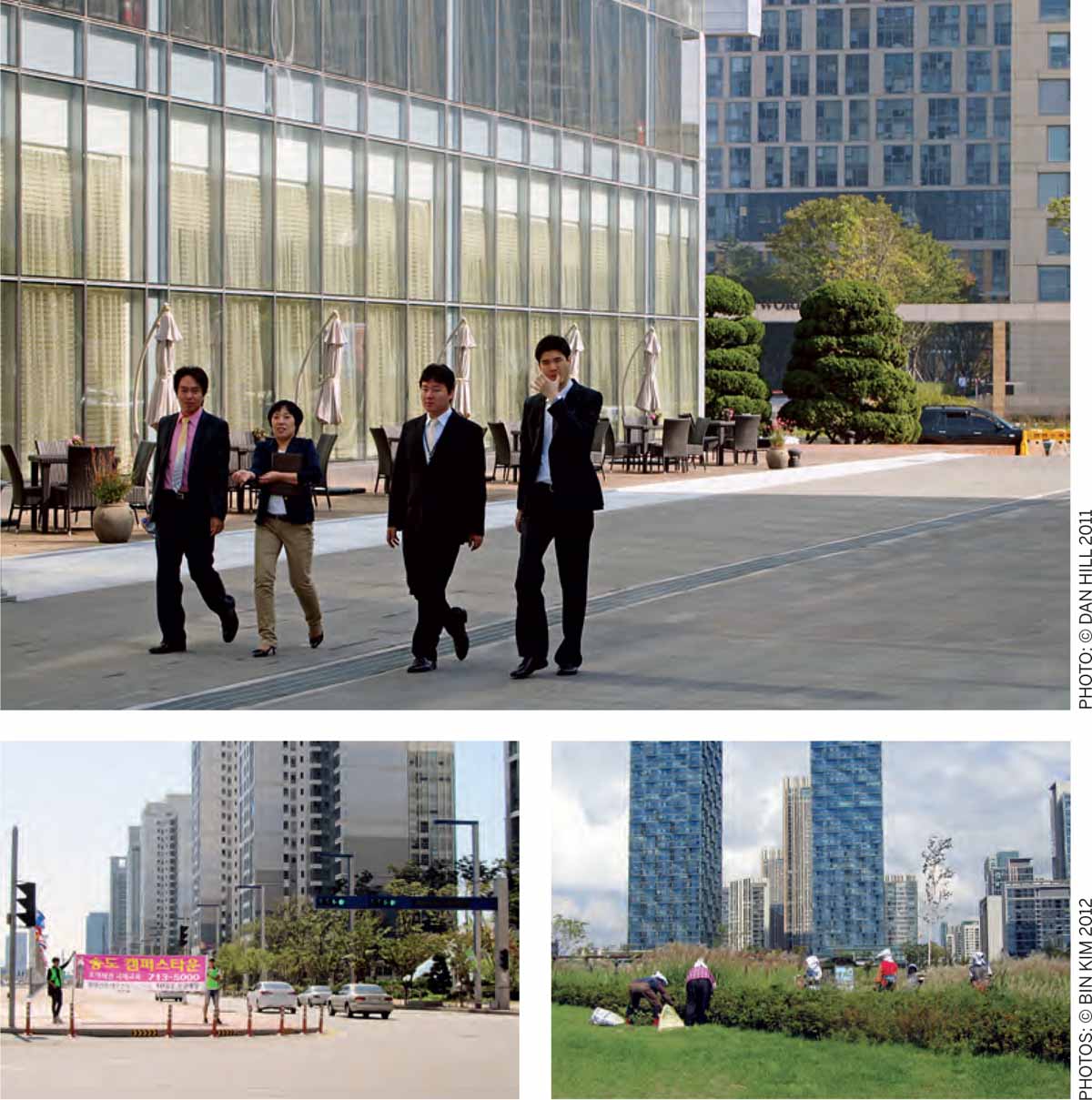
Bottom Left: The cut and paste towers in New Songdo reflect a commitment to replicability at the cost of a unique urban character
Bottom Right: Women maintaining the public green spaces provide a colourful contrast with Songdo’s muted architecture
Based on these critiques, a shorthand description of many smart cities might be ‘generic, inflexible, elitist and controlling environments’. These serious limitations are never acknowledged in smart city marketing material or high-level presentations. While we’re being sold the flashy new-ness of Songdo’s digital innovations, the bones of this city are actually incredibly old-fashioned. The traffic itself maybe smart, but the highway design is 50 years old. For these cities, there’s a glaring missed opportunity to explore a true synergy between urban planning and IT. How could smart technologies positively influence the spatial characteristics of our living environment? That’s the question everyone wants to see answered in a thoughtful, elegant way.
With this latest global wave of planned cities and towns, it has become clear that we still don’t understand what makes a good city. Despite what Stanley Gale and his PR team would have us believe, a city is not just pieces of a puzzle that can be reassembled at will. One of the first things an architecture student learns about is the Gestalt principle: this says that the whole is greater than the sum of its parts. For cities, especially planned cities, this concept is worth revisiting in depth. A truly smart city addresses not only every level of society but also the parts of the city that defy definition. It leaves room for spontaneity, flexibility and grass root-level initiatives. It welcomes diversity and embraces transparency rather than control. In the end, a city is only a reflection of its citizens and their collective will. What that says about Songdo should be a matter of concern, rather than inspiration.

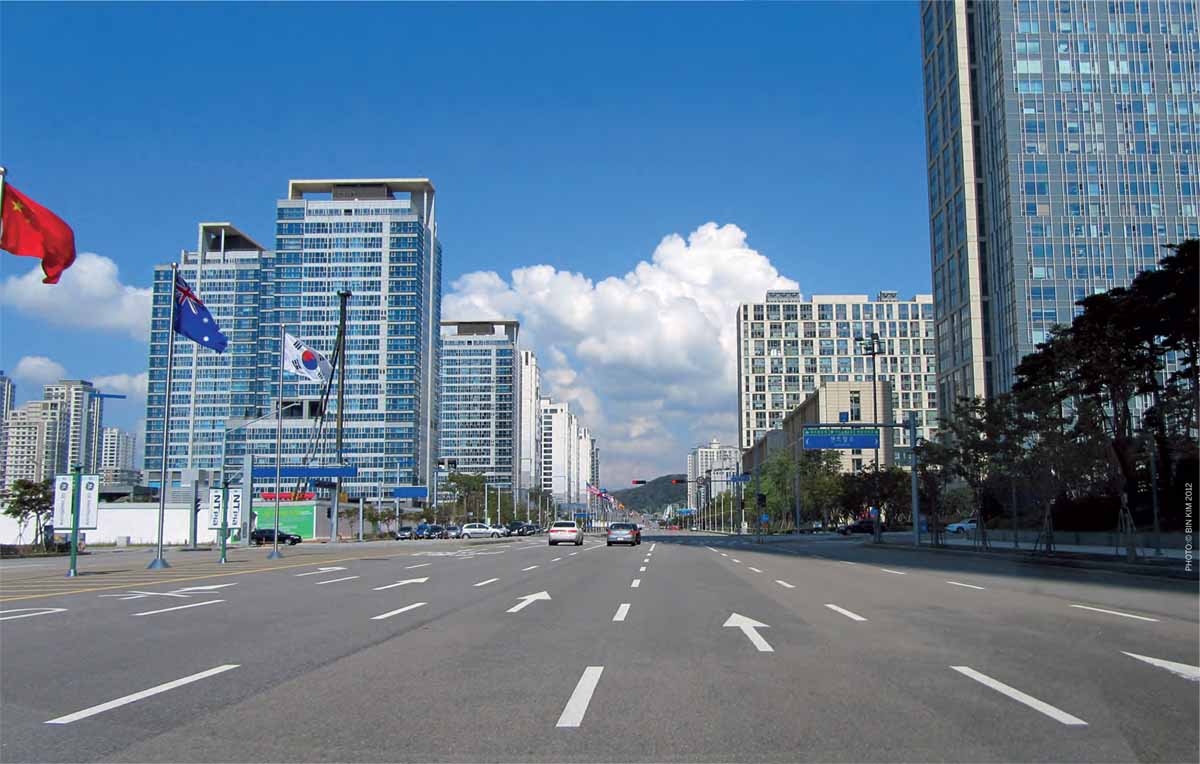

Comments (0)